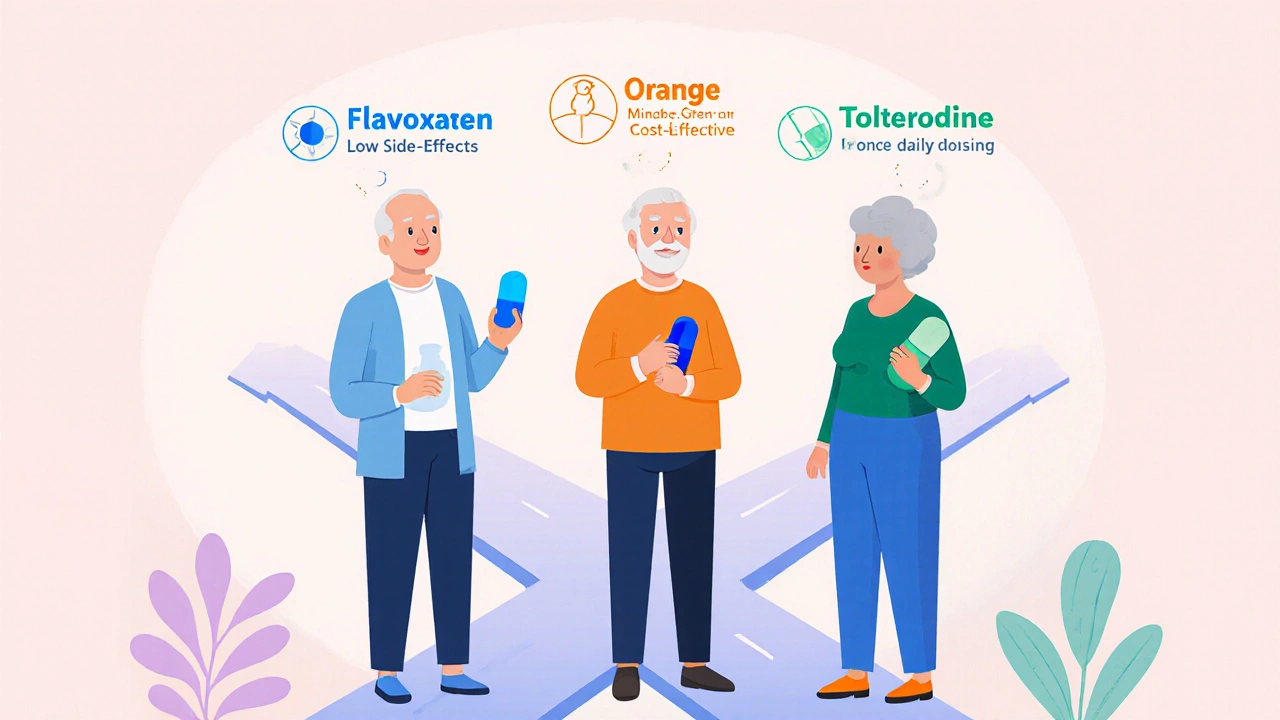When treating urinary urgency, Urispas (flavoxate) is a smooth‑muscle antispasmodic that helps relax bladder contractions. If you’ve been prescribed this drug or are shopping around for alternatives, you probably wonder how it stacks up against other options and which one fits your lifestyle best. This guide walks you through the science, the side‑effects, the price tags, and real‑world scenarios so you can make an informed choice without a pharmacy degree.
What is Flavoxate (Urispas)?
In the medical literature, Flavoxate is the generic name for Urispas, classified as a urinary antispasmodic that works by depressing the smooth‑muscle tone of the bladder wall. It’s typically prescribed for symptoms such as urinary frequency, urgency, and painful bladder spasms that aren’t caused by infection. Unlike many bladder drugs that block acetylcholine, flavoxate acts more like a muscle relaxant, which can mean fewer classic anticholinergic side effects like dry mouth.
How Does Flavoxate Work?
Flavoxate’s mechanism is fairly straightforward: it interferes with calcium influx in bladder smooth muscle cells, reducing the strength of involuntary contractions. The result is a calmer bladder that doesn’t send sudden “empty me now” signals to the brain. Because it doesn’t touch the nervous system directly, patients who are sensitive to anticholinergic drugs often tolerate flavoxate well.
Key Factors to Consider When Choosing a Bladder Medication
- Effectiveness: Does the drug reliably reduce urgency and frequency?
- Side‑effect profile: Which adverse reactions are most tolerable for you?
- Dosing convenience: Once‑daily, twice‑daily, or as needed?
- Drug interactions: Will it play nice with your current meds?
- Cost: What’s the out‑of‑pocket price in Australia?
- Prescription status: Some options are over‑the‑counter (OTC) in certain regions.
Using these criteria as a checklist helps you compare flavoxate with the most common alternatives on the market.

Common Alternatives to Flavoxate
Below is a quick snapshot of the drugs you’ll most often see in Australian prescriptions for overactive bladder (OAB) or urinary urgency.
| Medication | Mechanism | Typical Dose | Common Side Effects | Approx. Cost (AU$ / month) | Prescription? |
|---|---|---|---|---|---|
| Flavoxate (Urispas) | Smooth‑muscle antispasmodic | 200mg PO 3‑4×/day | Dizziness, mild GI upset | 30-40 | Yes |
| Oxybutynin | Anticholinergic | 5mg PO 2×/day | Dry mouth, constipation, blurred vision | 25-35 | Yes |
| Tolterodine | Anticholinergic | 2mg PO once daily | Dry mouth, headache | 35-45 | Yes |
| Solifenacin | Anticholinergic (M3‑selective) | 5mg PO once daily | Constipation, dry mouth | 45-55 | Yes |
| Darifenacin | Anticholinergic (M3‑selective) | 7.5mg PO once daily | Dry mouth, constipation | 50-60 | Yes |
| Trospium | Anticholinergic (quaternary, low CNS penetration) | 20mg PO BID | Dry mouth, constipation, dizziness | 30-40 | Yes |
| Mirabegron | Beta‑3 adrenergic agonist | 50mg PO once daily | Hypertension, nasopharyngitis | 70-85 | Yes |
Pros and Cons of Flavoxate Compared with Each Alternative
Below is a quick look at where flavoxate shines and where other drugs might have an edge.
- Flavoxate vs. Oxybutynin: Flavoxate causes fewer anticholinergic side effects (dry mouth, constipation). Oxybutynin, however, often delivers stronger symptom relief for severe urgency.
- Flavoxate vs. Tolterodine: Tolterodine offers once‑daily dosing, which beats flavoxate’s 3‑4times‑daily schedule. If you value simplicity, Tolterodine might win.
- Flavoxate vs. Solifenacin/Darifenacin: The newer M3‑selective agents have a lower risk of cognitive effects in older adults, a concern with older anticholinergics. Flavoxate avoids cognitive worries altogether because it isn’t an anticholinergic.
- Flavoxate vs. Trospium: Trospium is safer for people on multiple CNS‑active drugs, as it doesn’t cross the blood‑brain barrier. Flavoxate also stays out of the CNS, so both are good for polypharmacy patients.
- Flavoxate vs. Mirabegron: Mirabegron is the only non‑anticholinergic that works via beta‑3 receptors, making it a solid choice for patients who can’t tolerate any anticholinergic tone. It’s pricier, though, and may raise blood pressure.

Which Medication Fits Which Patient? - A Decision Guide
Use the scenarios below as a quick decision tree. Pick the bullet that feels closest to your situation, then see the recommended medication.
- If you’re over‑50 and worry about memory or confusion, avoid strong anticholinergics. Flavoxate or Trospium are safer bets.
- If you need once‑daily dosing for a busy schedule, consider Tolterodine, Solifenacin, or Mirabegron.
- If cost is a primary concern and your symptoms are moderate, Flavoxate or Oxybutynin (generic) provide the best value.
- If you have a history of dry mouth or constipation, stay away from traditional anticholinergics; Flavoxate or Mirabegron will be gentler.
- If you’re already on blood pressure medication and your doctor warns about hypertension, avoid Mirabegron and stick with Flavoxate or an anticholinergic.
- If you’ve tried an anticholinergic and it didn’t work, switching to a different class like Mirabegron or Flavoxate can give a fresh start.
Remember, the “best” drug varies by individual health profile, lifestyle, and tolerance. Discuss these factors with your prescriber and let them know which side effects matter most to you.
Tips for Talking to Your Doctor About Bladder Medications
- Bring a symptom diary: note frequency, urgency episodes, and any triggers.
- List all current medications, including over‑the‑counter supplements, to catch possible interactions.
- Ask about the expected onset of relief - some drugs start working in days, others may need weeks.
- Clarify the cost: ask if a generic version is available, or if a government subsidy applies.
- Discuss follow‑up: how soon should you report side effects and when to schedule a review?
Frequently Asked Questions
Can I take flavoxate if I’m pregnant?
Flavoxate is classified as a Category C drug in Australia, meaning risk cannot be ruled out. Most clinicians advise postponing its use until after delivery unless the bladder symptoms are severe and other options are unsuitable.
How quickly does Urispas start working?
Patients often notice a reduction in urgency within 2-3 days, but full symptom control may take up to two weeks of consistent dosing.
Is flavoxate safe for older adults?
Because flavoxate does not block acetylcholine, it carries a lower risk of confusion or falls compared with many anticholinergics. Still, the dose may need adjustment if kidney function declines.
Can I combine flavoxate with an anticholinergic?
Combining two bladder relaxants isn’t usually recommended because the additive side‑effects (dizziness, urinary retention) can outweigh benefits. Always check with a pharmacist before mixing.
What should I do if I experience severe dizziness on flavoxate?
Stop the medication and contact your doctor right away. Dizziness can signal blood‑pressure changes or an interaction with another drug you’re taking.


Lily Saeli
October 13 2025When faced with the choice of a bladder medication, we must ask ourselves what kind of person we wish to become. Do we chase the cheapest pill, or do we seek the one that respects our body's natural rhythm? Flavoxate offers a gentler approach, avoiding the anticholinergic storm that plagues many users. It does not tempt the mind with dry mouth or blurred vision, but instead eases the muscle tension with quiet dignity. The morality of medicine demands we prioritize safety over fleeting potency. A drug that preserves cognitive clarity is a virtue in an age of mental fog. The humble smooth‑muscle antispasmodic reminds us that strength can be soft. It teaches that relief need not be achieved through harsh interference. In the grand tapestry of health, each thread matters, and a mismatched thread can unravel the whole. Flavoxate’s modest side‑effect profile is a testament to ethical prescribing. We must not let the lure of strong anticholinergics blind us to long‑term consequences. The older anticholinergics may offer quick wins, but they also carry the risk of memory lapses, especially in the over‑fifties. By choosing a drug with a lower cognitive burden, we honor our future selves. The decision, therefore, is a moral one: protect the mind while easing the bladder. Let us walk the path of prudence, not of reckless haste. In the end, the true measure of a medication is how well it aligns with the values we hold dear.